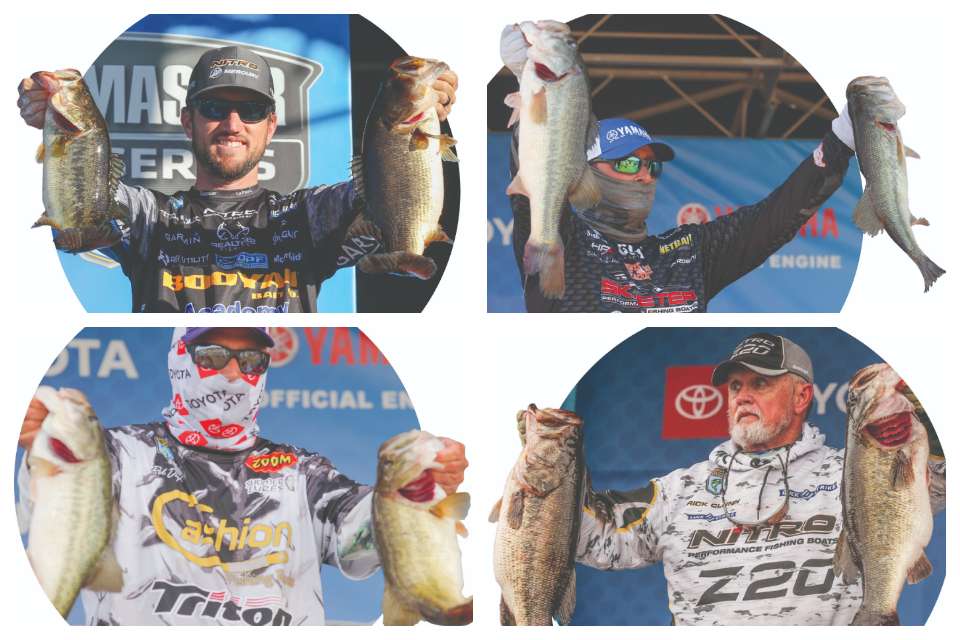
When summer transitions into fall, bass put on the feed bag and commence the weight-packing game plan. How far along we are in the seasonal changes determines much, so we turned to a handful of the nation’s top hawg snatchers for advice on how to catch a day-maker.
Of course, not all fisheries can be approached the same way. The monsters of Florida will be found in very different areas and eating very different things than the brown bass up north. So, the techniques, lures and experts have been divided by the different types of fisheries you may encounter across this great nation.
So, whether you plan to fish your local highland reservoir or will soon be casting in a flowing river, grab a pen and notepad and prepare to take some notes on how to target your personal best.
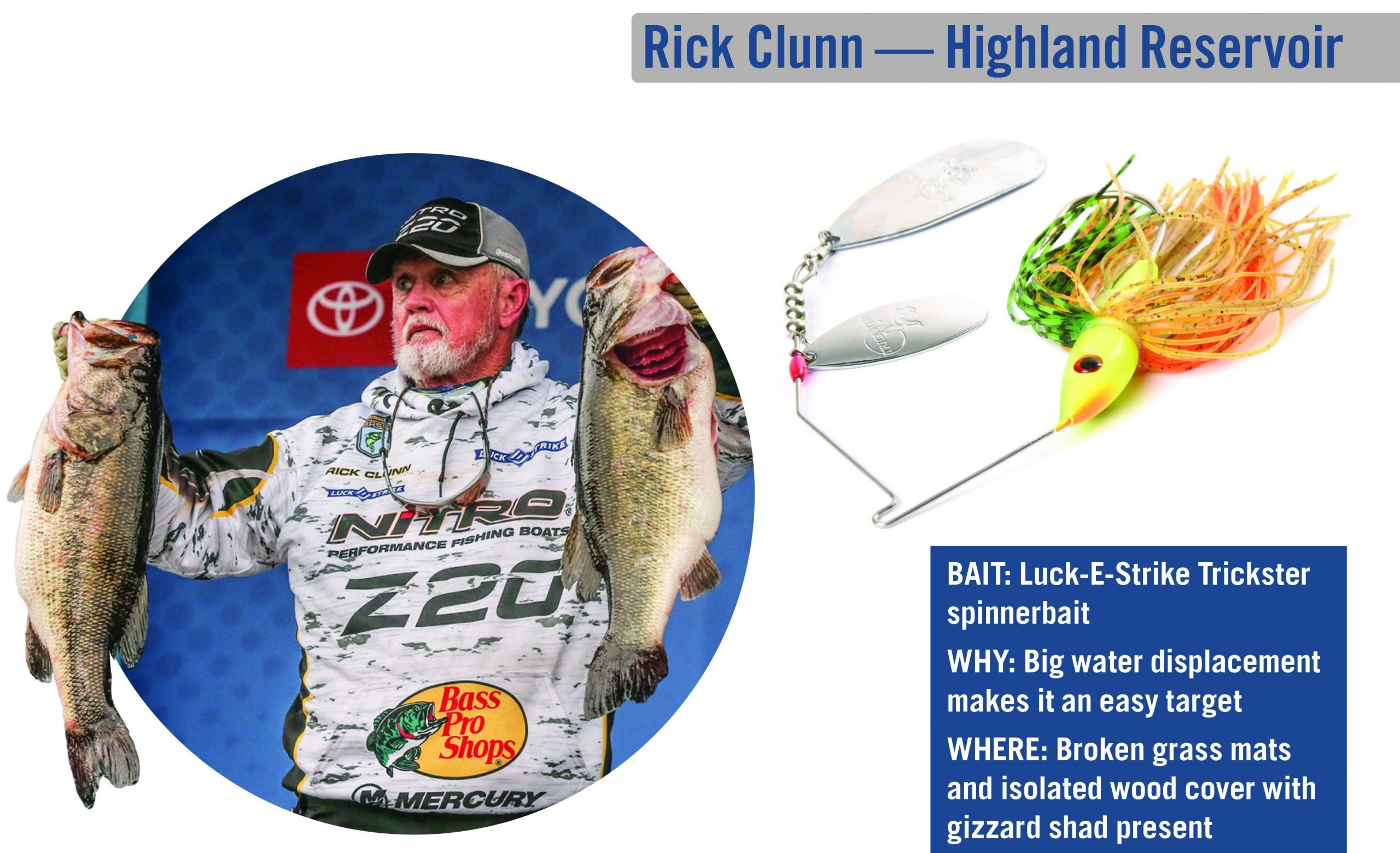
Rick Clunn
Weather and forage guide the tactical decisions for the four-time Bassmaster Classic champion, and if an early fall day brings cloudy, rainy prefrontal conditions, Clunn knows he can expect big results with a big spinnerbait — specifically, the tactics that helped earn his first Bassmaster Classic title at the 1976 event on Lake Guntersville.
Clunn’s go-to is a Luck-E-Strike Trickster spinnerbait that he described as “3/4-ounce-plus, pushing 1 ounce.” The size is key, Clunn said, because he needs that heavy head to manage the bait’s Long Drop blades. A cross between willowleaf and Indiana blades, the Long Drops deliver the big displacement he wants for enticing the giants.
“Most of the time, I’m burning it and waking the spinnerbait, and if you use a smaller head with those blades, the bait rolls,” Clunn said.
In stable conditions, Clunn holds high faith in the RICO popper, but if he’s spotting good numbers of hefty gizzard shad, he’ll upsize his topwater presentation to a Whopper Plopper or a buzzbait. Insightfully comparing bass and topwaters to lions forgoing the big, healthy water buffalo in favor of a young or injured target, Clunn said the surface deal fits nature’s M.O.
“A topwater is a good bait for big bass year-round because it obeys the predator-prey laws,” Clunn said. “Big bass don’t want to expend a lot of energy unnecessarily, so when nature presents a weakness, they’re programmed to eliminate that weakness.”
He won’t pass up sweet-looking logs and stumps, but Clunn’s main
fall target will be areas of fracturing vegetation. As he explains, shortening days and the cooling impacts of winter’s approach will find grass mats breaking apart. Tattered edges and peripheral clumps allow him to pinpoint specific little isolated targets.
“If you’re on a lake that doesn’t have grass, you [may have] main-lake points with broken rock. The key is finding where those gizzard shad are in the fall because that will bring more big fish to the area. In the fall of the year, they make a move to the creeks and banks for their final feed of the year, and your bigger fish will be around them.”
BAIT: Luck-E-Strike Trickster spinnerbait
WHY: Big water displacement makes it an easy target
WHERE: Broken grass mats and isolated wood cover with gizzard shad present
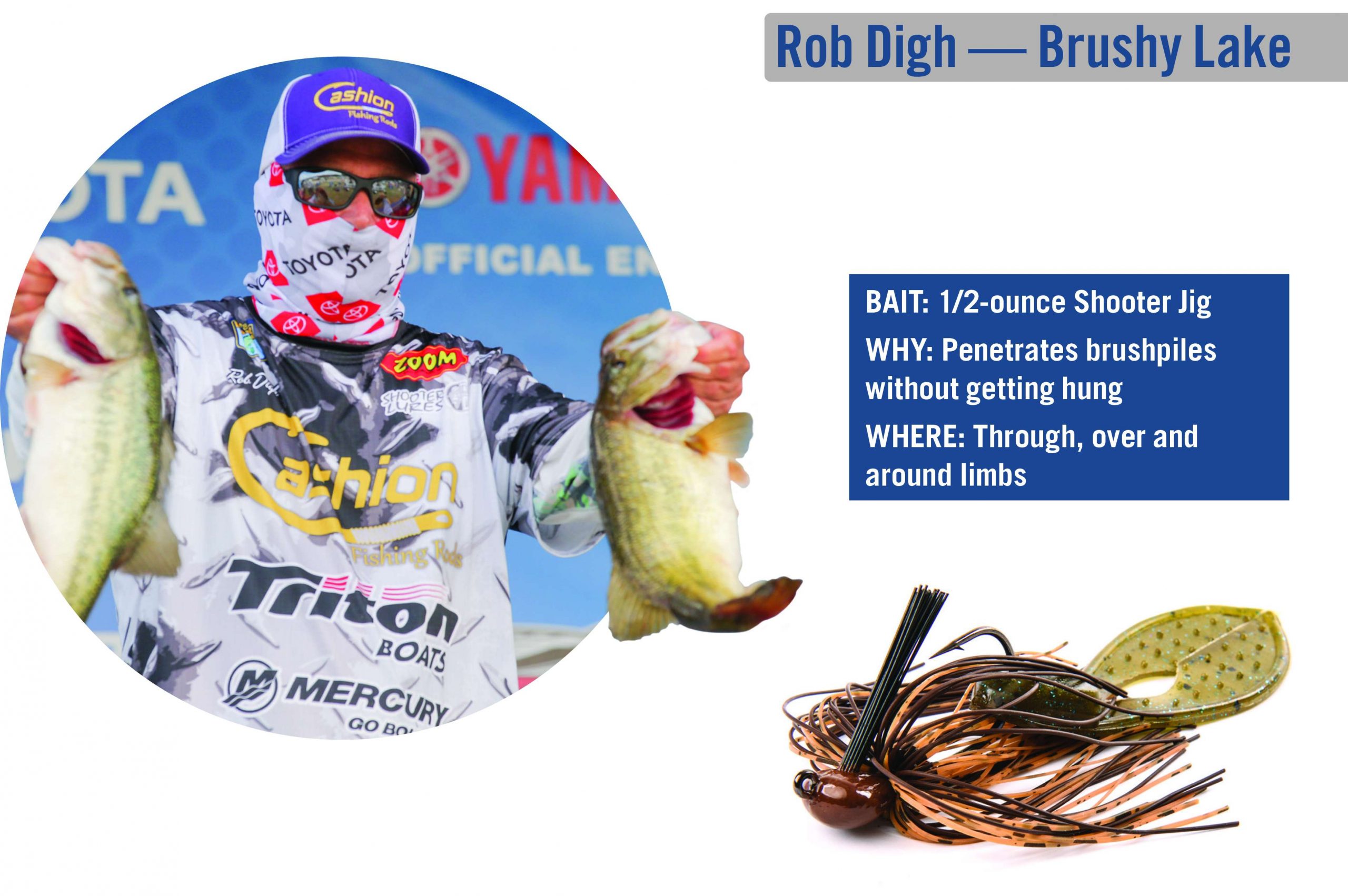
Rob Digh
The North Carolina pro catches a lot of stout fish by throwing jigs into brushpiles, but it’s Digh’s technical proficiency and adjustment insights that prove advantageous. Jigs are often an easy sell, but experience has taught him the value of very intentional presentations.
Digh typically starts with a 1/2-ounce Shooter Jig, which sports a hand-tied skirt for a more lifelike appearance, and adds a 3 1/2-inch Zoom Super Chunk or a 2-inch Super Chunk Jr., depending on what type of profile he wants. He always hangs the smaller trailer, but if he wants the Super Chunk’s size with a shorter overall bait length, Digh threads the trailer onto his jig’s hook and superglues it to the head.
“This also gives you a little more hook [exposure],” he said. “If I do tip it on the back, I’ll slide a piece of finesse worm onto the hook shank to keep the chunk from sliding up and down. So, when I cast, I know that chunk is laying where I want it to.”
Digh’s technique tip: “A lot of times when you throw into a brushpile, you may hit a limb. Instead of just pulling the bait across, I just tickle my rod to seesaw the bait back and forth on that limb. I’ll work each limb slowly, because this time of year, if the water hasn’t cooled off, they get kind of lazy and you have to let them look at your bait a little while.”
If the area’s getting pounded, Digh knows those big, smart fish will often shun the bulkier presentations. This, he said, makes them vulnerable to a subtler look.
“When fish are highly pressured, they tend to want a smaller bait, so I’ll downsize to a 1/4-ounce homemade football jig with a wide gap Gamakatsu hook and a Zoom Trick Worm,” Digh said. “Sometimes, I’ll throw around the outside edge of the brushpile and slowly drag along the bottom, because the fish don’t always lay in the brush.”
With either bait, Digh stressed the wisdom of handling a tangled fish with a controlled response. The tendency to vigorously pull until the fish pops free usually complicates matters, while a brief moment of slack often allows the fish to swim free from its entanglement.
BAIT: 1/2-ounce Shooter Jig
WHY: Penetrates brushpiles without getting hung
WHERE: Through, over and around limbs
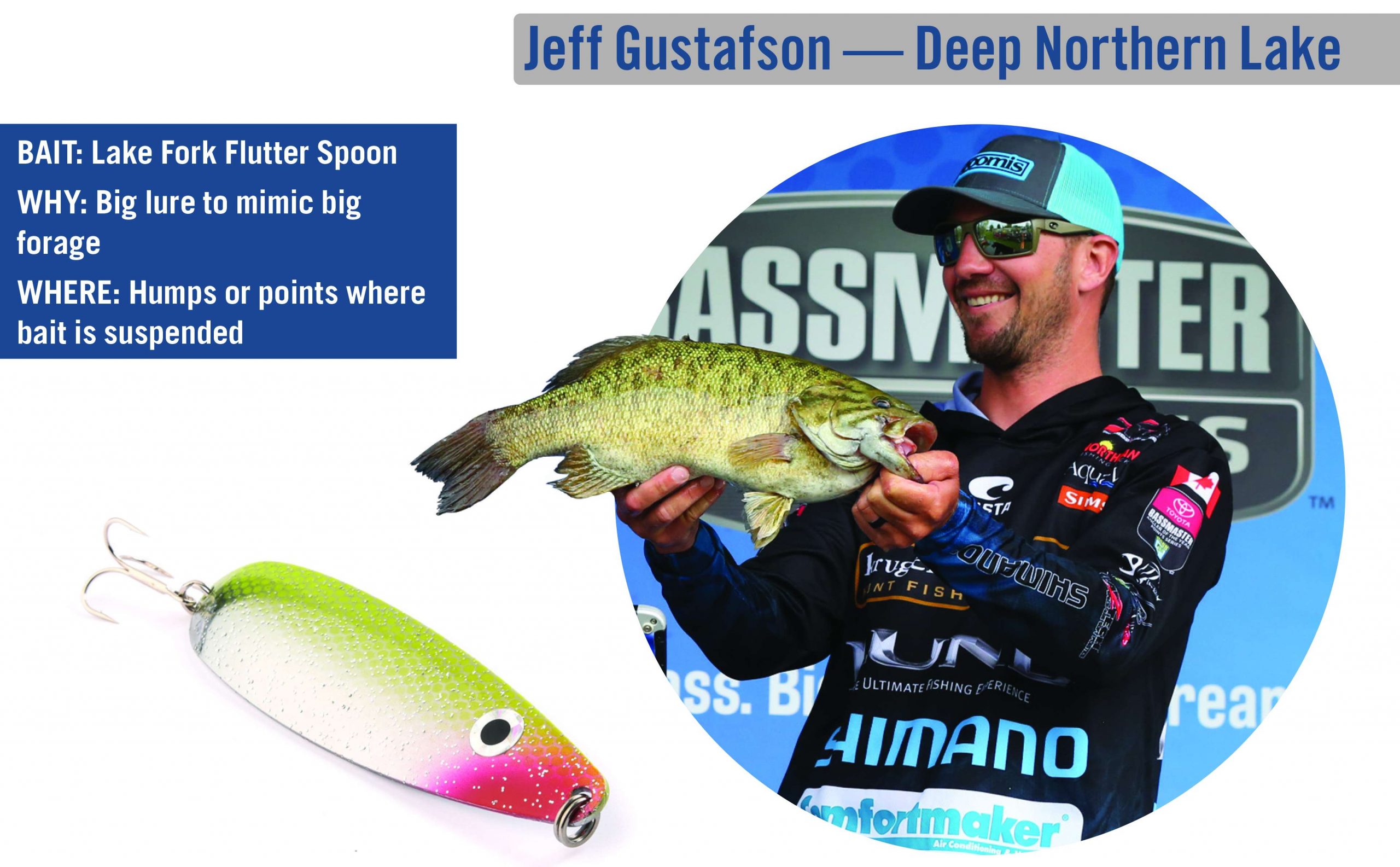
Jeff Gustafson
Fall finds jumbo smallmouth gorging on hefty meals, and Gustafson is happy to spoon-feed them — literally. The Elite angler from Keewatin, Canada, knows a big chunk of shiny metal offers his best bet for nabbing a brown bomber.
“I like a 5-inch, 1 1/8-ounce Lake Fork Flutter Spoon; that’s been my go-to in the fall,” Gustafson said. “This time of year, the fish get keyed on eating big baits, and up north, that could be shad, smelt or herring.
“A lot of the bait is suspended, so the bass follow them, but they’re going to be close to some type of structure, like a hump or a point. The fish will drift off the structure sometimes to chase a bait, and the spoon is good because it falls erratically and it has a lot of flash. It’s something you can use to attract a fish that’s hunting with its eyes.”
Gustafson said short, measured casts are best. No need for a heaving missile launch — in fact, that’s actually counterproductive.
“You don’t want to long bomb these things; a fast cast is best,” he said. “That way you have a vertical angle on the bait when it gets down there. You get better hook sets, and the spoon has the vertical action that we want.”
Gustafson throws his spoon on a 7-6 heavy G.Loomis rod with a Shimano Metanium 7:1 reel. Spooling with 20-pound fluoro allows him the strength he needs for slinging a big bait.
“I’ll pitch it out, keep my eye on the line, and when the spoon hits the bottom, I’m going to lift it 3 to 4 feet with pretty sharp rips and let it flutter back to the bottom,” Gustafson said. “I’ll just continue that all the way back to the boat.
“You really want to pay attention to your line; you’ll see your line jump when they bite it sometimes when it’s falling. But often, when you go to rip it back up, you’re setting the hook into one.”
Treble hooks and smallmouth are a constant recipe for heartbreak, but Gustafson said he usually expects a solid connection, as these voracious fall fish really “get” the bait. That being said, he’ll use the smallmouth’s tendencies to his advantage.
“Those fish are going to come up and jump close to the boat, so you should be prepared to boat flip them,” Gustafson said. “You definitely don’t want to baby them, because if they have a lot of time to play around with it, the spoon is an easy bait for them to throw.”
BAIT: Lake Fork Flutter Spoon
WHY: Big lure to mimic big forage
WHERE: Humps or points where bait is suspended
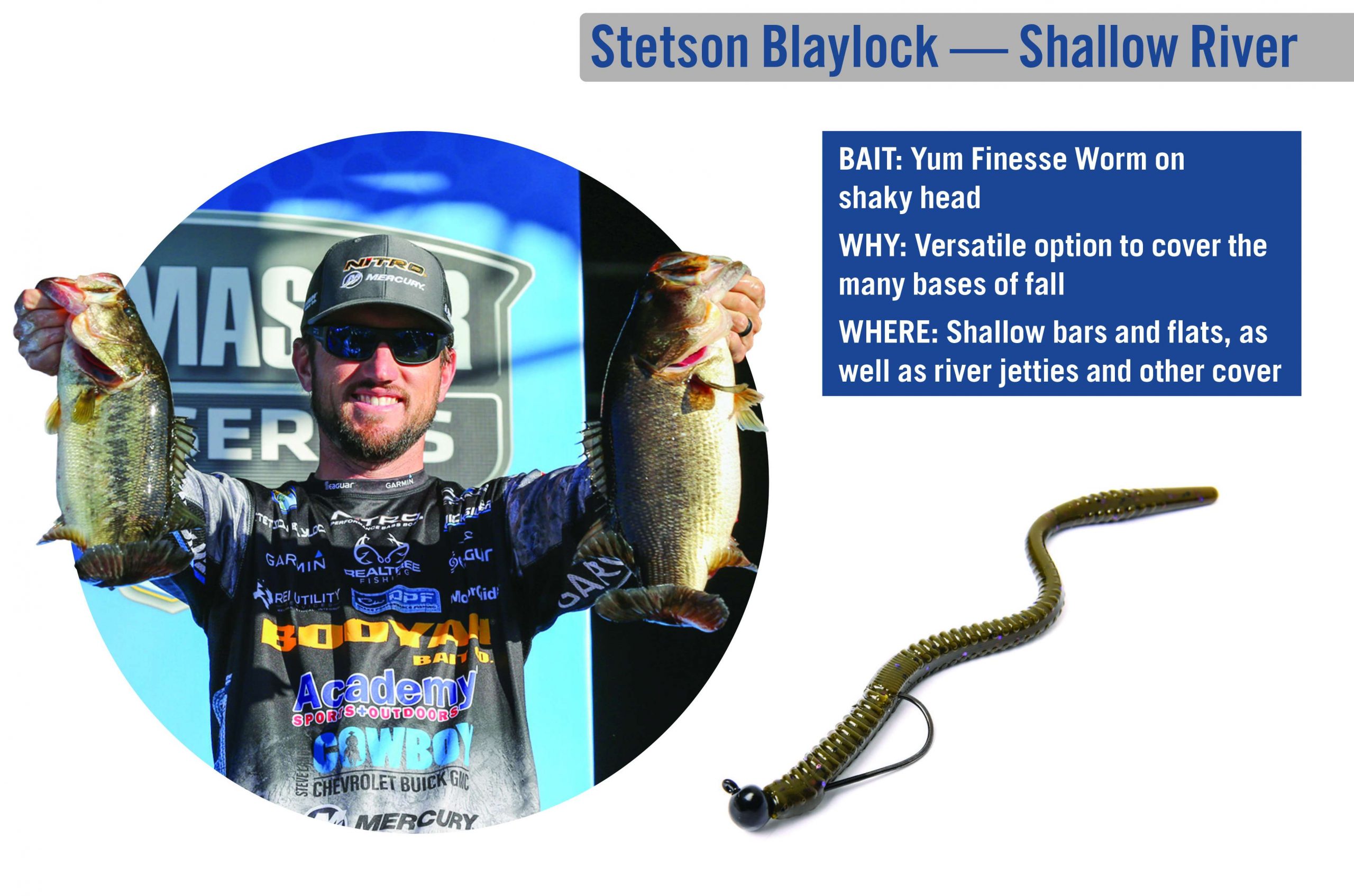
Stetson Blaylock
Highly adept at the river game, the Bassmaster Elite Series angler from Arkansas plans his big-fish strategy based on current. In a stagnant, low-flow scenario, before the fall fronts begin, Blaylock knows the big fish are hanging out on that main river, waiting on the first fronts to push shad back into the creeks. Here, he stakes his fortunes on a surprisingly modest presentation.
“I’ll throw a green pumpkin/purple Yum finesse worm on a 3/16-ounce shaky head on a spinning rod with braid and an 8- to 10-pound fluorocarbon leader and fish the main river — rock jetties, current breaks, even sand,” he said. “You’re throwing it around cover just like you’d be flipping or pitching a bigger bait; but that time of year, those big ones will eat that small shaky head just as good.
“That time of year, if there’s no flow, those fish suspend along the side of rock jetties or those sandbar drops where the sand has built up from the spring and summer rains. The fish just get out there and roam and look for baitfish, and a shaky head is a presentation that you can bomb cast over those flats and sandbars and pitch or flip it like a finesse powerbait.”
If the seasonal progression has pushed past the lethargic stuff — maybe the early fronts have brought enough rain to boost current flow — Blaylock’s supremely confident in a Booyah Pad Crasher frog in black or shad frog colors. This presentation allows him to efficiently work through some of the key areas fall fish will use for their seasonal feeding.
“I feel like those bigger fish are going to move back off the river and into those places where they can chase the shad,” he said. “In a shallow river, it’s going to be water willow, bank grass — those areas where they can ambush. I feel like throwing a frog is your best option if those fish have started making that move.”
Blaylock throws his frog on a 7-3 heavy H2O Xpress Ethos HD rod with 65-pound braid on an Ethos 8.1:1 reel that enables him to quickly pick up line and catch up to the fish. Worth noting: Blaylock likes the standard narrow-nose frog for this technique, as it’s less startling to shallow fish than a popping frog, but he uses a fast retrieve to force the big ones into reacting.
BAIT: Yum Finesse Worm on shaky head
WHY: Versatile option to cover the many bases of fall
WHERE: Shallow bars and flats, as well as river jetties and other cover
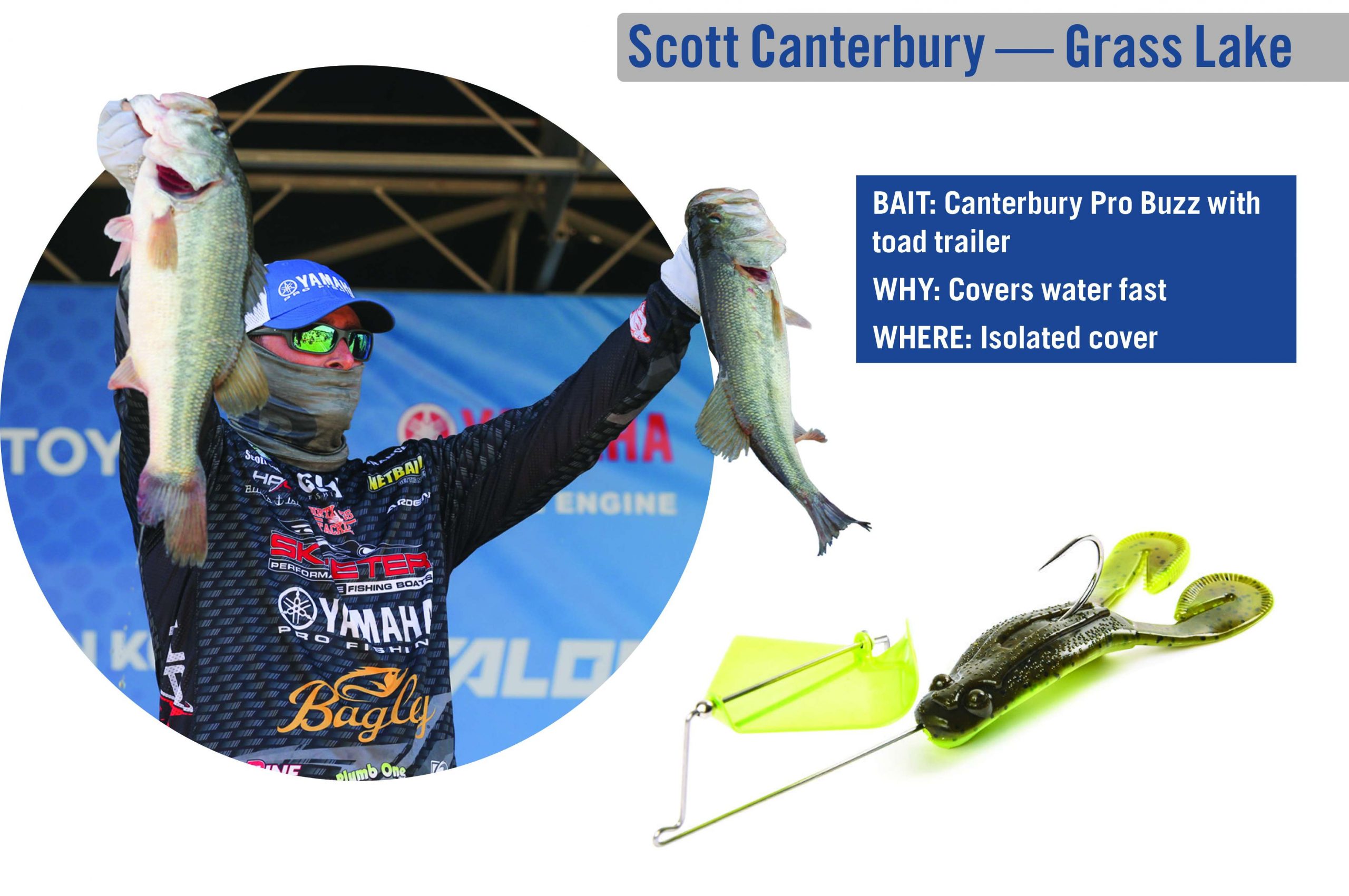
Scott Canterbury
Expecting a strong schooling tendency, Canterbury’s going to keep himself around the migrating bait schools and keep a bold topwater bait handy. His main choice is a 3/8- to 1/2-ounce Canterbury Pro Buzz. Other times of the year, he likes the 1/4-ounce version, but the heavier baits bring larger blades, and that’s just what Canterbury wants for provoking the giants.
“I’ll use a white trailer and I’ll start out with a toad and then go to a swimbait or fluke if they’re not hitting the toad,” Canterbury said. “I’m throwing this on 40-pound braided line with a 7-6 medium-heavy Halo rod and a 7.3:1 Ardent reel.
“Big fish tend to be in isolated clumps of grass, so be sure to hit every piece of isolated cover. Also, look for points, indentions and irregularities in the grass; that’s where a big bass will ambush baitfish.”
If the schooling subsides, either from fishing pressure or midday sun, Canterbury reaches into the water column with a Netbait Big Bopper paddle tail worm rigged on a 5/0 hook with a 5/16-ounce weight. Swimming this enticing bait through the grass often triggers a whopper that’s less inclined to run topside.
“That worm is really good if fish are up on a flat in stuff that you can’t really see and you’re just covering a massive area,” Canterbury said. “September in the South is still late summer, so with both of these baits, I’d stay [in the] main lake, but as we move into October, the fish will start moving back into the creeks and pockets.”
Worm bites are pretty straightforward, but Canterbury warns about missing a buzzbait opportunity. The strikes can be thrilling, but discipline puts giants in the boat. Plastic trailers help the fish get a better grip on the bait, but Canterbury’s big on a measured response.
“A lot of people don’t like using braid with buzzbaits because they take it away from the fish, but the rod I use has a soft tip, so it lets them get the bait better,” he said. “Don’t set the hook as soon as you get a blowup; reel down until you feel the fish and then set the hook.”
BAIT: Canterbury Pro Buzz with toad trailer
WHY: Covers water fast
WHERE: Isolated cover
Originally appeared in Bassmaster Magazine 2020.





